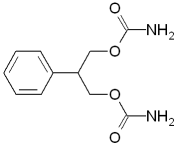Up to one quarter of children diagnosed with epilepsy are refractory to treatment with traditional antiepileptic drugs (AEDs). Once appropriate classification of the seizure disorder has been accomplished, an AED should be selected based on efficacy, side effect profile and pharmacokinetic characteristics. Unfortunately, there is a lack of controlled trials on the use of AEDs in children, and most agents have been labeled by the U.S. Food and Drug Administration (FDA) for use in adults only. Pellock reviews the current understanding of management of pediatric epilepsy with newer AEDs.
In 1993, felbamate was labeled for adjunctive treatment of partial and generalized seizures in children with Lennox-Gastaut syndrome. There were numerous reports of hepatotoxicity and aplastic anemia in adults, but there have been no reports of aplastic anemia in children younger than 13 years. Felbamate is therefore a treatment option in children whose seizures are not controlled with traditional AEDs. It proved to be highly beneficial in a study of children older than 10 years, who had a more than 50 percent reduction in the frequency of seizures while taking felbamate. Major side effects include aplastic anemia (possibly at a rate of one case per 8,000), anorexia, somnolence, nausea and vomiting, and gait abnormalities. An initial adjunctive dosage is 15 to 45 mg per kg per day, but much higher dosages may be needed. The author recommends that this drug be taken only in consultation with a pediatric neurologist.
Gabapentin is labeled by the FDA for adjunctive treatment of partial and secondarily generalized seizures in adults. It can be titrated quickly and easily, and its adverse effects (e.g., behavioral changes and aggression) are mild. Gabapentin's efficacy in children seems to be dosage-dependent. Initial dosage recommendations are 10 to 20 mg per kg per day, increasing to 30 mg per kg per day. Some children may need dosages as high as 60 to 100 mg per kg per day. One study showed particularly good response in mentally retarded children who had resistant partial epilepsy.
Lamotrigine is given to children in dosages ranging from 1 to 15 mg per kg per day. Careful dosing attention is needed because adverse effects are much more common at higher dosages. Serious rashes have been reported in up to 12 percent of patients, often in children who are also taking valproate and whose dosage is titrated rapidly. The rash may progress to Stevens-Johnson syndrome or toxic epidermal necrolysis. Lamotrigine seems to be especially useful in children with Lennox-Gastaut syndrome, generalized epilepsy syndromes and refractory partial epilepsy.
Tiagabine is labeled for adjunctive treatment of partial seizures. Although higher dosages (up to 56 mg per day) seem to be most effective, dosing starts in children at 0.1 mg per kg per day. As with most newer AEDs, data in children are limited, but this medication seems to be effective in children with partial seizures. Tiagabine selectively inhibits the uptake of g-aminobutyric acid and, as such, might be useful in the treatment of infantile spasms. Further studies are needed. Side effects include headache, dizziness and somnolence. Topiramate may be useful as adjunctive and monotherapy in children with refractory partial seizures. The initial dosage is 1 mg per kg per day, with titration up to 6 mg per kg per day. Major side effects include somnolence, dizziness, psychomotor slowing, paresthesias and confusion. Some adult patients have also developed nephrolithiasis and weight loss.
One investigational medication, vigabatrin, has been shown to be quite effective in a number of pediatric epilepsies, especially infantile spasms. It has also been used successfully in children with Lennox-Gastaut syndrome but may exacerbate myoclonic seizures.
The author concludes that first-line treatment of pediatric epilepsy should still involve the use of conventional AEDs. However, the newer AEDs offer more options, especially in children with refractory seizures. The accompanying table summarizes treatment guidelines for new antiepileptic drugs.
Pellock JM. Managing pediatric epilepsy syndromes with new antiepileptic drugs. Pediatrics November 1999; 104:1106-16.
COPYRIGHT 2000 American Academy of Family Physicians
COPYRIGHT 2000 Gale Group



